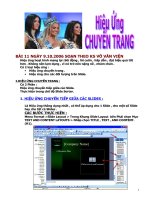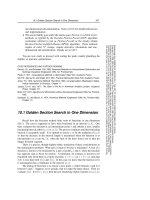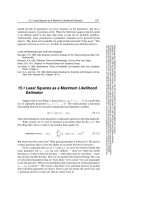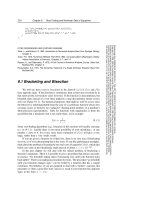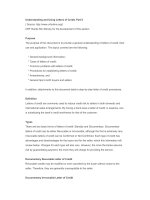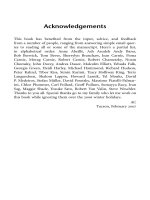ENCYCLOPEDIA OF NEEDLEWORK - PART 2 doc
Bạn đang xem bản rút gọn của tài liệu. Xem và tải ngay bản đầy đủ của tài liệu tại đây (36.02 MB, 332 trang )
ENCYCLOPEDIA
OF
NEEDLEWORK - PART 2
BY
THÉRÈSE DE DILLMONT
ENGLISH EDITION
ALL RIGHTS RESERVED
Tatting.
On account of a similarity in their construction, a chapter on tatting seems to form a
natural sequence to the one on crochet and is in some ways a preparation for that on
macramé which succeeds it.
The English name of tatting is said to be derived from «tatters» and to denote the frail
disconnected character of the fabric. By the Italians it was formerly called «occhi»,
whilst in the East it still bears the name of «makouk», from the shuttle used in making
it.
In the eighteenth century, when tatting was in great vogue, much larger shuttles than
our present ones were used, because of the voluminous materials they had to carry,
silk cord being one.
Shuttles.—The tatting shuttle consists of two oval blades of either bone, ivory,
mother of pearl or tortoise-shell, pointed at both ends, and joined together in the
middle. A good shuttle contributes materially to the rapid and perfect execution of the
work and attention should be paid in its selection to the following particulars: that it
be not more than 7 c/m. long and 2 or 3 c/m. wide: that the two ends be close enough
to prevent the thread from protruding; this is more especially important in tatting with
two shuttles and lastly, that the centre piece that joins the two oval blades together
should have a hole bored in it, large enough for the thread to pass through.
In filling the shuttle, be careful not to wind on too much thread at once, or the blades
will gape open at the ends and the thread get soiled by constant contact with the
worker's hands.
Materials.—A strongly twisted thread such as Fil d'Alsace D.M.C, Fil à dentelle
D.M.C, or Cordonnet 6 fils D.M.C, is best for tatting. We particularly recommend Fil
d'Alsace, as forming the best shaped knots and picots. A soft material such as Coton à
tricoter D.M.C, can also be used where it suits the purpose better.
First position of the hands (fig. 486).—The construction of the knots or stitches,
appears at first sight to present great difficulties but will be easily mastered by
attention to the indications here given. One thing, to be constantly borne in mind is,
that when the right hand has passed the shuttle through the loop, it must stop with a
sudden jerk and hold the thread tightly extended until the left hand has drawn up the
knot. After filling the shuttle, take the end of the thread between the thumb and
forefinger of the left hand, and the shuttle in the right, pass the thread over the third
and fourth fingers of the left hand, bring it back towards the thumb and cross the two
threads under the fingers, as indicated in fig. 486. Pass the thread that comes from the
shuttle round the little finger of the right hand, and give the shuttle the direction
shown in the engraving.
Fig. 486. First
position of the hands.
Second and third position of the hands (figs. 487 and 488).—Make the shuttle pass
between the first and third fingers, in the direction indicated by the arrow in fig. 487,
and bring it out behind the loop.
Fig. 487. Second position of
the hands.
Here the first difficulties for beginners arise and until they have sufficiently mastered
the movements of both hands not to confuse them, we advise them to pay careful
attention to the following instructions. As soon as you have put the shuttle through the
loop, place the right hand on the table with the thread tightly extended, leaving the left
hand perfectly passive.
Fig. 488.
Third position of the hands.
Then, raising the third and fourth fingers of the left hand with the loop upon them, pull
up the loop, stretching the thread tightly in so doing by extending the fingers. By this
movement a knot is formed, the first part of the «double knot», which is the most
common one in tatting.
Remember that the right hand must be kept perfectly still as long as the left is in
motion and that the knot must be formed of the loop thread that is in the left hand.
The right hand, or shuttle thread, must always be free to run through the knots; if it
were itself formed into knots it would not have the free play, needed for loosening and
tightening the loop on the left hand, as required.
Fourth position of the hands (fig. 489).—The second part of a knot is formed by the
following movements: pass the shuttle, as indicated in fig. 489, from left to right,
between the first and third fingers through the extended loop; the right hand seizes the
shuttle in front of the empty loop and extends the thread; the left hand pulls up this
second part of the knot as it did the first.
Fig. 489. Fourth position of the hands.
Single or half knots. Josephine picots (figs. 490 and 491).—The Josephine picot or
purl, as it is also called in tatting, consists of a series of single or half knots formed of
the first knot only. These picots may be made of 4 or 5 knots, as in fig. 490, or of 10
or 12 knots, as in fig. 491.
Fig. 490. Single or half knots. Small josephine picot.
Fig. 491. Single or half knots. Large josephine picot.
Fifth position of the hands (fig. 492).—When the second knot forming the double
knot has been made, the two hands resume the position shown in fig. 487. Fig. 492
reproduces the same and shows us a few finished knots as well.
Fig.
492. Fifth position of the hands.
Position of the hands for making a picot (fig. 493).—Picots are introduced into
tatting patterns as they are into knitting and crochet. They also serve to connect the
different parts of a pattern together and render a great many pretty combinations
feasible.
Fig. 493. Position of the hands for making a picot.
Open and close picot (figs. 494 and 495).—These are formed of single knots, leaving
a loop on the extended thread, as shown in fig. 494, and a short length of thread
between the knots; finish the second half knot and when you have pulled it up, join it
to the preceding knot. In this manner the picot represented in fig. 495 is formed quite
naturally.
Fig. 494. Open picot.
Fig. 495. Close picot.
In every kind of tatting the knot that comes after the picot is independent of the loop.
Thus if the directions say: 2 knots, 1 picot, 3 knots, 1 picot, 2 knots, etc., you must
count the knot that served to form the loop and not make: 2 knots, 1 picot, 4 knots,
etc. To join the different rings, ovals, etc., together by means of picots, take up the
thread that runs over the left hand with a crochet needle, inserting it into the picot
downwards from above, draw the thread through and pull it up like any other knot.
Tatting with two shuttles (fig. 496).—Two shuttles are used in tatting when the little
rings are not to be connected together at the bottom by a thread, when you want to
hide the passage of the thread to another group of knots and when threads of several
colours are used.
Fig. 496.
Tatting with two shuttles.
When you work with two shuttles, tie the two threads together. Pass one thread over
the third finger of the left hand, wind it twice round the fourth finger and leave the
shuttle hanging down.
Pass the second shuttle into the right hand and make the same movements with it as
you do in working with one shuttle only.
Detached scallops (fig. 497).—Make 12 double knots with one shuttle, then tighten
the thread so as to draw them together into a half ring; the next knot must touch the
last knot of the scallop before it.
Fig. 497.
Detached scallops.
Materials: Fil d'Alsace D.M.C in balls Nos 30 to 70 or Cordonnet 6 fils D.M.C Nos.
25 to 50.[A]
Scallops joined together at the top (fig. 498). With one shuttle make 4 double, 1
picot, * 8 double, 1 picot, 4 double, close the half ring, 4 double, draw the thread
through the picot and repeat from *.
Fig. 498.
Scallops joined together at the top.
Materials: Fil d'Alsace D.M.C Nos. 30 to 70, Cordonnet 6 fils D.M.C Nos. 15 to 40,
or Fil à dentelle D.M.C Nos. 25 to 60 [A]
Scallops with picots (fig. 499).—Make with one shuttle: 4 double, 1 picot, * 3
double, 1 picot, 2 double, 1 picot, 2 double, 1 picot, 3 double, 1 picot, 4 double, close
the ring.
Fig. 499.
Scallops with picots.
Materials: Fil d'Alsace D.M.C in balls Nos. 30 to 70, écru or white.[A]
Leave sufficient length of thread before beginning the next ring, for the rings not to
overlap each other = make 4 double, draw the left hand thread through the 5th picot of
the preceding ring and repeat from *.
Tatted insertion (fig. 500).—Make with one shuttle a ring like the ones in fig. 499,
then leaving a length of, from 5 to 10 m/m. of thread, make a second ring = turn the
work = leave the same length of thread again, begin a third ring which you join after
the 4th double, to the 5th picot of the 1st ring = turn the work after each ring is made,
so that all the upper rings represent the right side of the work and all the lower ones
the wrong.
Fig. 500. Tatted insertion.
Materials: Fil d'Alsace D.M.C in balls Nos. 30 to 70, écru or white.
Tatted insertion (fig. 501).—To be worked with two shuttles. Begin with one thread
and one shuttle and make a ring, as in figs. 499 and 500; and a second close to it; then
pass the thread over the left hand, take the second shuttle in the right hand and make 6
double on the 2nd thread, after which you again make a ring above and one below
with one shuttle only.
Fig. 501. Tatted insertion.
Materials: Fil d'Alsace D.M.C Nos. 30 to 70, or Cordonnet 6 fils D.M.C No. 20.
Edging of tatting and crochet (fig. 502).—Make with one shuttle: 1 double, 1 picot,
2 double, 1 picot, 2 double, 1 picot, 2 double, 1 picot twice as long as the others, 2
double, 1 picot, 2 double, 1 picot, 2 double, 1 picot, 2 double, 1 long picot, 1 double =
close the ring = fasten off the two threads on the wrong side with two or three stitches.
Fig. 502. Edging of tatting and crochet.
Materials—For the tatting: Fil d'Alsace D.M.C in balls No. 30. For the crochet:
Cordonnet 6 fils D.M.C No. 60.
After the first knot join the next ring to the preceding one by the long picot, and work
the remainder as has been already described.
When you have a sufficient number of rings, pick up the picots by crochet trebles with
3 chain stitches between them. On this first row, crochet a second, consisting of: 2
chain, 1 picot, 2 chain, 1 single in the treble of the 1st row. To finish the bottom part
of the work, make 1 plain in the 1st picot, 3 chain; 1 plain in the 2nd picot, 3 chain, 1
plain in the 3rd picot, 1 chain, 1 plain in the 1st picot of the next ring.
One row of single crochet serves as a footing to the edging.
Tatted edging in three rows (fig. 503).—Worked with two shuttles. The first row is
worked like fig. 495, with one shuttle. The second and third are worked with two.
Fig. 503. Tatted edging in three rows.
Materials: Fil d'Alsace D.M.C in balls Nos. 30 to 70, or Cordonnet 6 fils D.M.C Nos.
20 to 60.
Fasten the thread of the right hand shuttle into the first picot; then work on this thread
the same number of double knots and picots as in the 1st row and join each half ring to
the picot of the row before. In the 3rd row, insert 3 picots between the 8 double knots
of the row above. Here the Josephine picot may be substituted for the plain picot.
Tatted edging (fig. 504).—Worked with two shuttles and two colours. After making a
string of rings like those in fig. 502, with Fil d'Alsace D.M.C No. 30 écru, fasten the
blue and unbleached threads of the respective shuttles to the middle picot. Holding the
light thread in the right hand, and the dark one laid over the left hand, work: 3 double,
1 picot, 3 double = then put the right hand thread separately through the 2 picots of the
rings and continue to make: 3 double, 1 picot, 3 double.
Fig. 504. Tatted edging.
Materials: Fil d'Alsace D.M.C in balls Nos. 30 to 70, or Fil à dentelle D.M.C Nos. 25
to 50.
Colours: Écru and Bleu-Indigo 334, or Jaune d'Ocre 667 and Rouge-Cornouille 450,
Gris-Tilleul 331 and Brun-Caroubier 356.
The next row also is made with two shuttles. Hold the light thread in the right hand;
with the dark thread, laid across the left hand, make: * 4 double, 1 picot, 2 double, 1
picot, 2 double = turn the work = with the right hand shuttle make: 6 double, put the
thread through the little picot formed above the middle picot of the rings, 6 double,
close the ring = turn the work = make with two shuttles: 2 double, 1 picot, 2 double, 1
picot, 4 double, put the light thread through the 2 blue picots and repeat from *. The
first row of crochet for the footing consists of chain and plain stitches only, the
second, of chain stitches and trebles.
Medallion (fig. 505).—Take two colours of thread and fill two shuttles with the light
colour and two with the dark. Make with one shuttle: 24 double and 12 picots, 6 of
them short and 6 long; close the ring, break off the thread and fasten off the ends by a
stitch or two on the wrong side.—For the next 4 rows take two shuttles.
Fig. 505.
Medallion.
Materials: Fil d'Alsace D.M.C in balls Nos. 30 to 50.[A]
Colours: White and Rouge-Géranium 352, or écru and Vert-Mousse 471, Bleu pâle
668 and Jaune d'Or 676.
1st row—with the shuttles containing the light colour = fasten the ends on to a short
picot and make: * 3 double, 1 short picot, 2 double, 1 long picot, 2 double, 1 long
picot, 2 double, 1 long picot, 2 double, 1 short picot, 3 double; pass the right hand
thread through one of the short picots of the first ring, repeat the series 5 times from *.
When you reach the 6th half ring, instead of making the second picot, put the left hand
thread through the short picot of the first half ring, then complete the last double
knots, cut the threads off, pass them through the picot of the ring and fasten them off
on the wrong side.
2nd row—with the shuttles filled with the light colour = fasten the ends on to a long
picot, then make: * 4 double, 1 picot, 4 double, pass the right hand thread through the
picot of the first row and repeat the series 17 times from *.
3rd row—with the shuttles filled with the dark colour = fasten the ends on to one of
the picots of the last row and make: * 4 double, pass the right hand thread through the
picot of the 2nd row, make a long picot, 4 double and repeat this series all round the
medallion, until you have 18 scallops.
4th row—with the shuttles filled with the dark colour = * 2 double, 1 picot, 2 double,
1 picot, 2 double, 1 picot, 2 double, pass the right hand thread, from the wrong side,
through the picot of the 2nd row and begin again from *.
Insertion of tatting and crochet (fig. 506).—Fill two shuttles, one with a light
colour, say, Bleu de France 344, the other with a darker, such as Jaune-Rouille 365,
and two numbers coarser than the thread you intend to use for the crochet. Begin with
the dark colour and make: * 4 double, 1 picot, 8 double, 1 picot, 4 double, close the
ring. With both shuttles, the light colour in the left hand: 4 double, 1 picot, 2 double, 1
picot, 2 double, 1 picot, 4 double, put the right hand thread through the picot of the
first circle; then add: 4 double, 1 picot, 2 double, 1 picot, 2 double, 1 picot, 4 double.
Fig. 506. Insertion of tatting and crochet.
Materials: Fil d'Alsace D.M.C in balls Nos. 30 to 70, or Fil à dentelle D.M.C Nos. 25
to 50.
Colours: Bleu de France 344 and Jaune-Rouille 365.
With the shuttle, filled with the dark colour: 5 double, pass the thread through the
picot of the first ring, make 8 double, 1 picot, 5 double, close the ring. Then, leaving a
short length of thread between, make: 4 double, put the thread through the picot of the
preceding ring, 8 double, 1 picot, 4 double, close the ring **; then repeat from * to **.
When you have thus made two equal lengths, join them together with crochet, using a
thread two numbers finer than the tatting thread; if the latter for instance was Fil
d'Alsace No. 30, you would take No. 50 of the same material for the crochet—1 plain
in the 1st picot, 5 chain, 1 plain in the middle picot, 5 chain, 1 plain in the 3rd and 1st
picot = then, over 5 chain: 1 sextuple cluster stitch (fig. 426), 5 chain.
In the row on the opposite side of the tatting, take out the crochet needle at the 3rd
chain stitch and put it in from beneath into the corresponding stitch of the opposite
row; in this manner join the two insertions together so as to complete the pattern.
Insertion of tatting and crochet (figs. 507 and 508).—Worked with one shuttle. The
tatting thread should be two numbers coarser than the crochet thread. Begin with 2
strings of half rings consisting of: 4 short picots and 3 long. Leave a length of thread
between, equal to the diameter of the ring.
Fig. 507. Insertion of tatting and crochet.
Materials—For the tatting: Fil d'Alsace D.M.C in balls Nos. 30 to 70, or Cordonnet 6
fils D.M.C Nos. 25 to 50, écru or white.[A]
For the crochet: The same materials, but two numbers finer.
When the two strings of half rings are finished, crochet with the fine thread: 6 plain
over each length of thread between, and at the base of the scallops.
Fig. 508. Working
detail of fig. 507.
2nd row—5 chain, 1 plain in the 4th plain of the 1st row.
In the row that connects the two rows of tatting, put the 3rd chain stitch into the
corresponding stitch of the opposite row.
For the outside edge make: 1 plain in the 1st short picot, 8 chain *, 1 treble in the 2nd
short picot, 7 chain, 1 treble in the 3rd short picot, 8 chain, 1 plain in the 4th short
picot, 1 plain in the short picot opposite, 3 chain, pass the thread through the 4th of the
8 chain stitches, 4 chain and repeat from *.
For the last row make: 3 plain in each of the 3 last of 8 chain, * 1 picot of 5 chain
above the treble, 4 plain in the 4 next chain, 1 picot, 1 single in the same stitch as the
plain before the picot, 3 plain, 1 picot, 3 plain, miss the 1st and the last stitch, then
make 3 plain on the next scallop and repeat from *.
Edging of tatting and crochet (fig. 509).—Worked with two shuttles and in two
shades. With the light shade: 2 double, 1 short picot, 2 double, 1 long picot, * 2
double, 1 picot of the ordinary size, 2 double, 1 picot, 2 double, 1 picot, 2 double, 1
long picot, 2 double, 1 short picot, 2 double, close the ring = with 2 shuttles: 3 double,
pass the thread through the 1st picot, make 3 double, 1 long picot, 2 double = with the
light shade: 4 double, pass the thread through the 9th picot of the 1st ring, make 3
double, 1 picot, 4 double, close the ring = with 2 shuttles: 2 double, 1 picot, 3 double,
1 short picot, 3 double = with one shuttle: 2 double, pass the thread through the empty
picot of the small ring, make 2 double, pass the thread through the long picot of the
big ring, then repeat from *.
Fig. 509. Edging of tatting and crochet.
Materials—For the tatting: Fil d'Alsace D.M.C in balls No. 30 in two shades of one
colour.
For the crochet: Fil d'Alsace D.M.C in balls No. 50 in one colour only.
To complete the edge, crochet first one row, consisting of: * 1 plain in the 1st of the 5
picots of the big ring, 4 chain, 1 plain in the 2nd picot, 4 chain, 1 plain in the 3rd
picot, 4 chain, 1 plain in the 4th picot, 4 chain, 1 plain in the 5th picot and repeat from
*.
2nd row—2 plain on the 3rd and 4th of the first chain stitches = over the 2nd and 3rd
chain: 1 plain, 1 half treble, 2 trebles, 1 half treble, 1 plain; on the 4 last chain: 2 plain.
For the footing make: 1 plain in the long picot, 5 chain, 1 plain in the next picot, 5
chain, 1 double treble in the short picot, leave the 2 last loops of the treble on the
needle = 3 trebles in the first lower loop of the double treble, keep the last loops of
these 3 trebles on the needle, after the 4th treble, draw the needle through the 4
trebles. The last row consists of: 3 chain, 1 treble over 5 chain.
Tatted medallion (fig. 510).—Worked with two shuttles and two colours.
Fig. 510. Tatted medallion.
Materials: Fil d'Alsace D.M.C Nos. 30 to 50.[A]
Colours: Gris-Tilleul 330 and Rouge-Cardinal 304.[A]
1st row—with one shuttle: 12 double and 6 picots, close the ring.
2nd row—with two shuttles and the dark coloured thread laid across the left hand =
knot the threads into one of the picots of the 1st ring: 1 double, 1 long picot, 2 double,
pass the right hand thread through one of the picots of the ring, 1 picot, 2 double and
so on. After the 12th picot fasten off the threads on the wrong side by two or three
stitches.
3rd row—with one shuttle: * 3 double, pass the thread through one of the picots of the
2nd row, make 3 double, close the ring = leave 5 m/m. of thread = turn the work = 4
double, 1 picot, 4 double, close the ring = leave 5 m/m. of thread again and repeat 11
times from *.
4th row—with two shuttles; fasten the ends to one of the picots of one of the 12 rings
of the 3rd row: * 3 double, 1 picot, 3 double = with one shuttle: 3 double, pass the
thread through the picot, 3 double, 1 picot, 2 double, 1 picot, 3 double, close the ring =
close to this: 3 double, pass the thread through the 2nd picot of the 1st ring, 3 double,
1 picot, 3 double, close the ring = again, close to the last ring: 3 double, pass the
thread through the picot of the 2nd ring, 2 double, 1 picot, 3 double, close the ring =
with 2 shuttles: 3 double, pass the thread through the 2nd picot of the 3rd ring, 3
double, fasten the thread to the picot of the ring of the 3rd row and repeat 11 times
from *.
5th row—with two shuttles and the dark colour across the left hand: 6 double and 2
picots over the lower rings and 10 double and 4 picots over the upper rings.
Tatted edging (fig. 511).—With two shuttles and with the two colours indicated, or in
any other combination of colours.
Fig. 511. Tatted edging.
Materials: Fil d'Alsace D.M.C in balls Nos. 30 to 70, Cordonnet 6 fils D.M.C Nos. 40
to 50, or Fil à dentelle D.M.C Nos. 25 to 40.
Colours: Gris-Tilleul 330 and Rouge-Grenat 326.
Begin with two shuttles, the red thread across the left hand = 10 double, 1 picot, 6
double = with one shuttle: 6 double, 1 picot, 6 double, close the ring = turn the work =
make a second ring like the first and close to it = turn the work = with two shuttles: 6
double, 1 picot, 6 double = with one shuttle: 6 double, pass the thread through the
picot of the ring opposite, 6 double, close the ring = 6 double, 1 picot, 6 double, close
the ring = turn the work to make the next half ring.
Make 3 rows of half rings connected by rings. In the 2nd row, you pass the thread
from the ring through the picot to which the 2nd ring was fastened in the 1st row.
For the outside scallops, make with one shuttle: * 5 double, pass the thread through
the picot that connects 2 rings, 5 double, close the ring = with two shuttles: 4 double =
with one shuttle: 2 double, 1 picot, 2 double, 1 picot, 2 double, pass the thread through
the picot of the half ring of the 3rd row, 2 double; then 8 picots more with 2 double
between each, close the ring = with two shuttles: 4 double, 1 long picot, 2 double, 1
short picot, 2 double, 1 short picot, 3 double = with one shuttle: 5 double, pass the
thread through the 3rd picot of the big ring, 5 double, close the ring = with two
shuttles: 2 double, 6 picots with 2 double after each picot = with one shuttle: 5 double,
pass the thread through the 3rd picot of the big ring, 5 double, close the ring = with
two shuttles: 3 double, 1 picot, 2 double, 1 picot, 2 double, 1 picot, 4 double, pass the
right hand thread through the 6th picot of the big ring = with two shuttles: 4 double,
then repeat from *.
The footing is worked in crochet and consists of one row of chain stitches and one of
trebles.
Square of tatting (fig. 512).—Worked with two shuttles and two colours. With the
light colour: 2 double, 1 picot, 4 double, 1 picot, 4 double, 1 picot, 4 double, 1 picot, 2
double, close the ring.
Fig.
512. Square of tatting.
Materials: Fil d'Alsace D.M.C in balls Nos. 30 to 100, Cordonnet 6 fils D.M.C Nos.
10 to 60, or Fil à dentelle D.M.C Nos. 25 to 70. [A]
Colours: Jaune-Rouille 366 and Brun-Caroubier 359.[A]
1st row—with two shuttles, the dark coloured thread across the left hand = fasten the
thread to a picot and make: * 2 double, 1 picot, 2 double, 1 picot, 2 double, 1 picot, 2
double, pass the right hand thread through the picot of the ring; 1 picot over the
connecting thread, then repeat 3 times from *. The last picot over the picot of the
small ring is made at the end.
2nd row—with two shuttles, the light thread over the left hand = fasten the thread to
the picot over the light picot: * 2 double, pass the right hand thread through the picot
of the 1st row, 1 long picot over the lower picot, 3 double, pass the thread through the
next picot of the 1st row = in the corner, 1 rather longer picot than the one before, 3
double, pass the right hand thread through a picot, 1 long picot, 2 double, pass the
thread through a picot; repeat 3 times from *. To form the last picot, fasten off the
thread on the wrong side by two or three stitches.
3rd row—with one shuttle and the dark colour: * 4 double, pass the thread through the
picot above the picot of the small ring, 4 double, close the ring = leave 10 m/m. of
thread, make a second ring like the 1st = leave 10 m/m. of thread, make 6 double, pass
the thread through the long picot, 6 double, close the ring = leave 10 m/m. of thread,
make another ring of 12 knots, fasten it to the same picot, the preceding knot is
fastened to; then make a ring of 8 double knots and repeat 3 times from *.
4th row—with one shuttle and the light colour and worked like the 3rd row, leaving a
rather longer length of thread between; then make: 16 instead of 12 double for the
corner rings.
5th row—with one shuttle and the light colour = 8 double, fasten the thread to one of
the corner loops and between 2 rings of the 4th ring: 8 double, close the ring = turn the
work = leave a length of thread, 3 double, 1 picot, then 4 times 2 double knots and 1
picot, 3 double, close the ring. Make the second ring as close as possible to the first,
beginning and finishing the second with 5 double knots = make a 3rd ring like the 1st,
join it to the 2nd ring by the 4th picot = turn the work = make another ring of 16 knots
and join it to the same loop of the 4th row, to which the two other rings are already
joined = turn the work = 1 ring above, with 4 picots, like the first one we described,
then a ring of 12 double knots below.
At the top, 6 detached half rings, placed between 3 connected rings, which form the
corners. The top rings are to be joined after the 3rd double knot, to the 4th picot of the
preceding ring.
6th row—with two shuttles and the dark colour only = fasten the threads to a picot
that serves as a connecting link, take the dark thread over the left hand and make: 3
double, 1 picot, 2 double, 1 picot, 2 double, 1 picot, 3 double = fasten the thread to the
connecting picot and carry the half rings all round the square.
Macramé stripe—Arabic subject.
Macramé.
Macramé is an Arabic word, signifying an ornamental fringe or trimming, which has
been adopted as the term for a certain kind of hand-work, known also as «knotted
fringe» or «Mexican lace» and produced by the knotting, interweaving and tying
together of threads.
We have given the preference to the Arabic name because of its less definite meaning,
seeing that not only fringe and lace, but trimmings of all kinds, in the shape of bands
and stripes and headings, can be worked in macramé.
Until its revival about ten years ago, when it was regarded by many as a new
invention, the art of macramé making had for centuries become almost extinct and
save here and there in the convents, was quite unknown.
The multitude of uses to which it can be turned as a trimming, the infinite variety it
admits of and its great durability and strength, make macramé well worth a study; the
difficulties that repel many at first sight are only on the surface and any one who
carefully follows the instructions given in the following pages, will soon overcome
them and be able without pains to copy the charming designs that accompany them,
which remind us of the wooden lattices in the windows of Eastern houses, doubtless
familiar to many of our readers, under the name of moucharabieh.
Materials.—These may be of almost any kind; silk, gold thread, cord, wool or cotton,
can all be employed with good effect. Almost any of the D.M.C cottons can be used
for macramé; but the ones especially to be recommended are: Fil à dentelle D.M.C[A],
Cordonnet 6 fils D.M.C[A] and Coton à broder D.M.C[A] for the finer kinds of work,
and for the coarser, Fil à pointer D.M.C[A], Coton à tricoter D.M.C[A] and Ganse
turque D.M.C[A]. The twist in all these is so regular as to admit of a high degree of
perfection being attained with them: they are moreover very agreeable to the touch, a
great recommendation considering how much they have to be handled by the worker.
Macramé cushion and other accessories (figs. 513 and 514).—The only really
important requisite for macramé work is the cushion, which should be well stuffed,
and weighted with lead (fig. 513). It is convenient to have it made to screw on to a
table like the Swiss tambour frames. There are other kinds of macramé cushions but
none, in our opinion, as practical as these because any pattern can be worked upon
them and patterns that have a heading or a border of picots can not be worked on any
others. The pegs at the ends of the cushion are for fixing and winding the long threads
upon, which carry the knots, and which we shall in future call «cords».
Fig. 513. Macramé cushion.

